Business IT Management: Strategies, Challenges and Solutions Report
VerifiedAdded on 2022/08/12
|12
|3892
|32
Report
AI Summary
This report provides a comprehensive analysis of IT management within organizations, addressing critical success factors for introducing new technologies, best practices for knowledge management, and the challenges of managing IT in both global and non-global environments. The report explores strategies and solutions for effective IT management in a global context, covering knowledge management implementation, technological integration, and the importance of organizational culture and employee engagement. It discusses the problems associated with knowledge management, such as resistance to change and difficulties in quantifying knowledge, and suggests methods to overcome these issues. Furthermore, the report highlights the significance of aligning IT goals with business objectives and the need for robust security measures. The report also emphasizes the importance of flexible organizational structures, adapting to market changes, and fostering a culture that embraces learning and innovation. Finally, it examines the implementation of IT systems, including the functions of information systems, security considerations, and the need for strategic planning and budgeting to ensure successful IT management in a global environment.
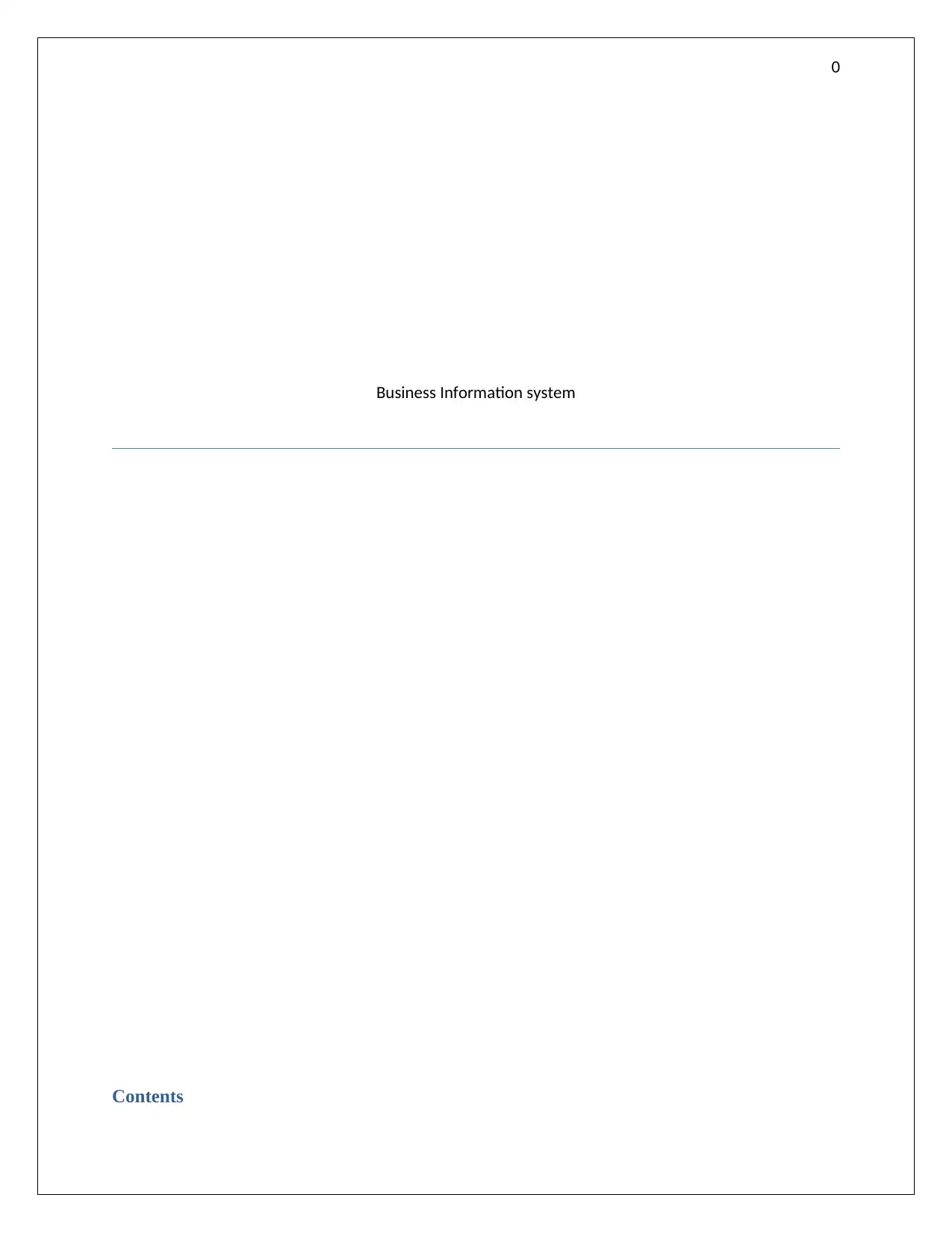
0
Business Information system
Contents
Business Information system
Contents
Paraphrase This Document
Need a fresh take? Get an instant paraphrase of this document with our AI Paraphraser
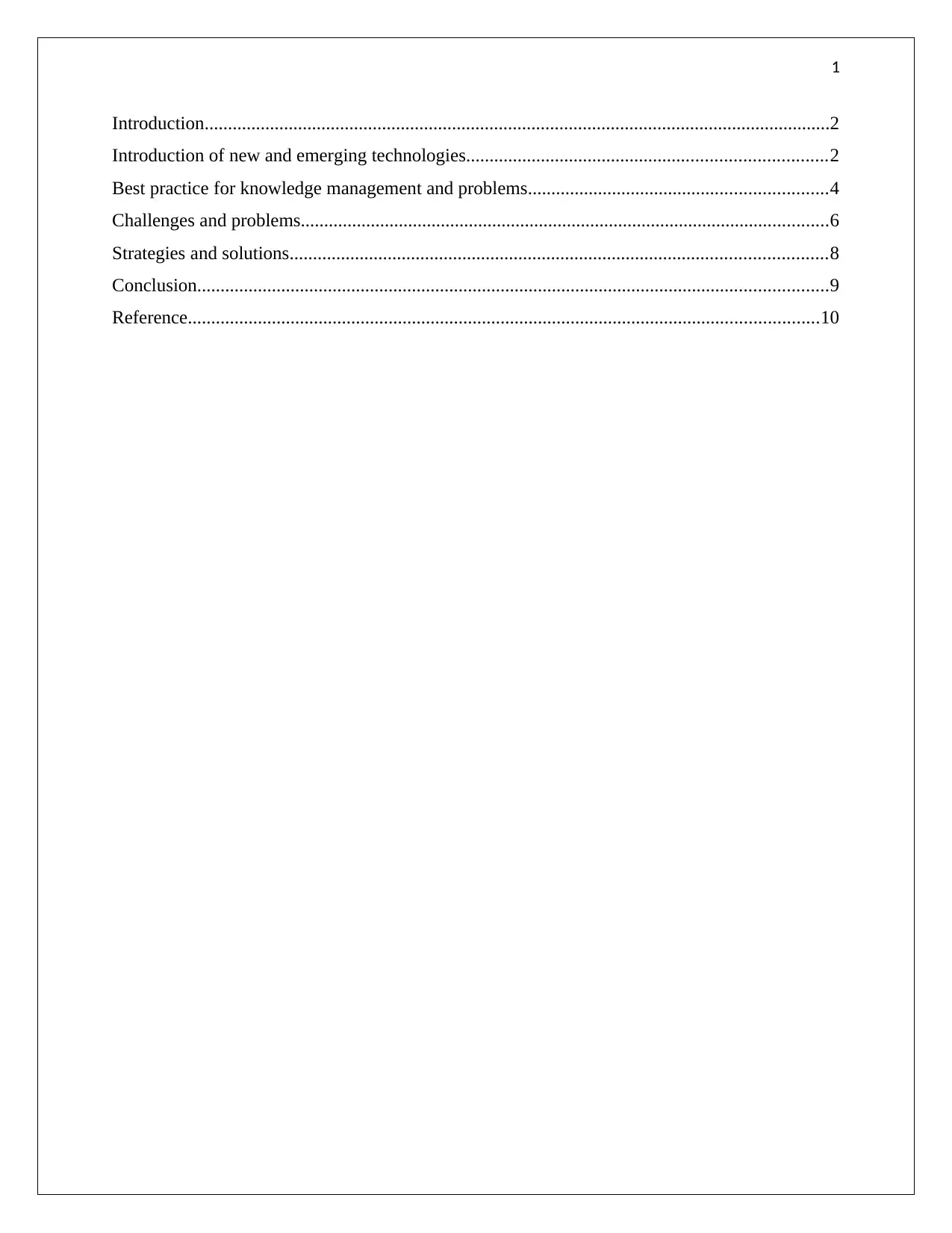
1
Introduction......................................................................................................................................2
Introduction of new and emerging technologies.............................................................................2
Best practice for knowledge management and problems................................................................4
Challenges and problems.................................................................................................................6
Strategies and solutions...................................................................................................................8
Conclusion.......................................................................................................................................9
Reference.......................................................................................................................................10
Introduction......................................................................................................................................2
Introduction of new and emerging technologies.............................................................................2
Best practice for knowledge management and problems................................................................4
Challenges and problems.................................................................................................................6
Strategies and solutions...................................................................................................................8
Conclusion.......................................................................................................................................9
Reference.......................................................................................................................................10
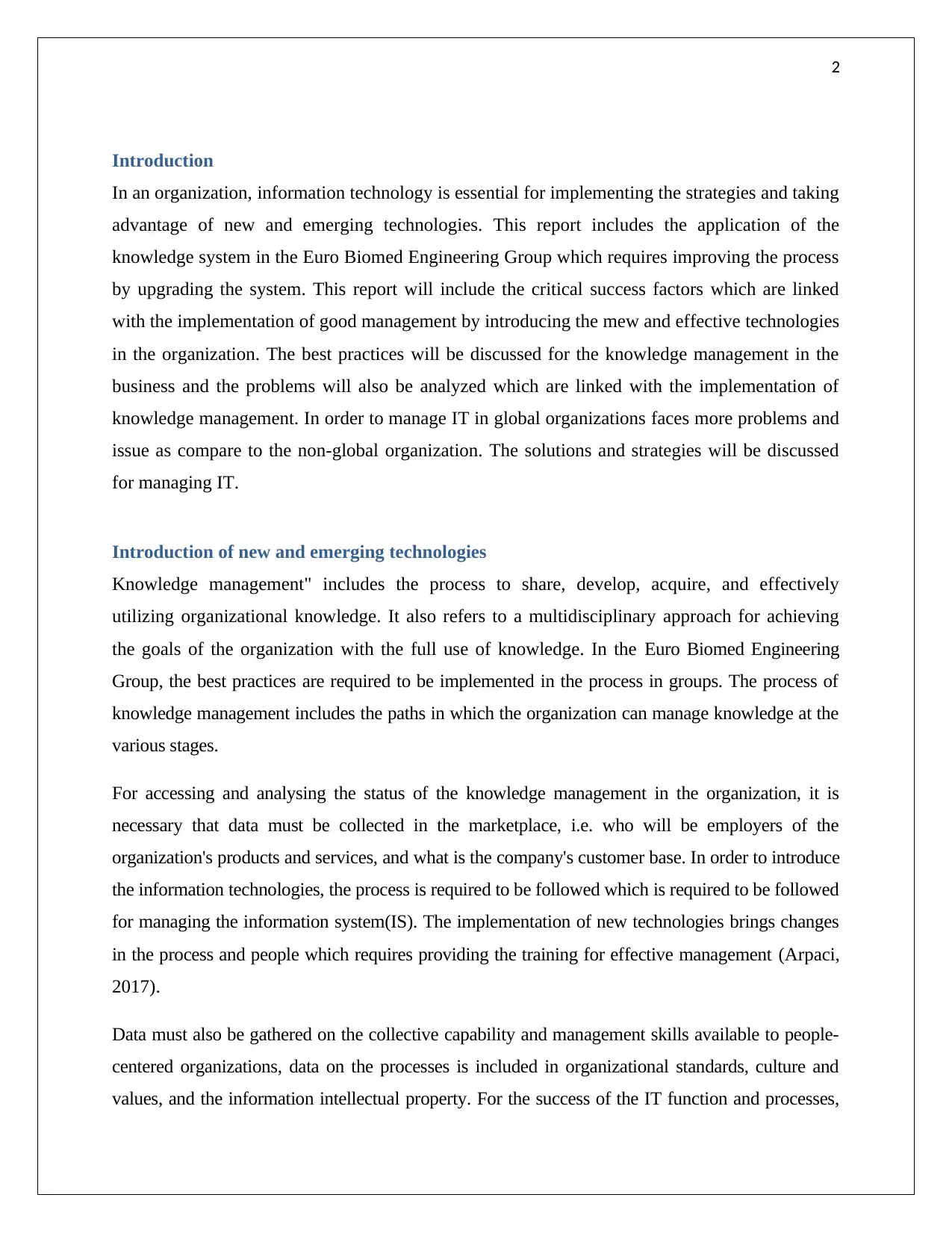
2
Introduction
In an organization, information technology is essential for implementing the strategies and taking
advantage of new and emerging technologies. This report includes the application of the
knowledge system in the Euro Biomed Engineering Group which requires improving the process
by upgrading the system. This report will include the critical success factors which are linked
with the implementation of good management by introducing the mew and effective technologies
in the organization. The best practices will be discussed for the knowledge management in the
business and the problems will also be analyzed which are linked with the implementation of
knowledge management. In order to manage IT in global organizations faces more problems and
issue as compare to the non-global organization. The solutions and strategies will be discussed
for managing IT.
Introduction of new and emerging technologies
Knowledge management" includes the process to share, develop, acquire, and effectively
utilizing organizational knowledge. It also refers to a multidisciplinary approach for achieving
the goals of the organization with the full use of knowledge. In the Euro Biomed Engineering
Group, the best practices are required to be implemented in the process in groups. The process of
knowledge management includes the paths in which the organization can manage knowledge at the
various stages.
For accessing and analysing the status of the knowledge management in the organization, it is
necessary that data must be collected in the marketplace, i.e. who will be employers of the
organization's products and services, and what is the company's customer base. In order to introduce
the information technologies, the process is required to be followed which is required to be followed
for managing the information system(IS). The implementation of new technologies brings changes
in the process and people which requires providing the training for effective management (Arpaci,
2017).
Data must also be gathered on the collective capability and management skills available to people-
centered organizations, data on the processes is included in organizational standards, culture and
values, and the information intellectual property. For the success of the IT function and processes,
Introduction
In an organization, information technology is essential for implementing the strategies and taking
advantage of new and emerging technologies. This report includes the application of the
knowledge system in the Euro Biomed Engineering Group which requires improving the process
by upgrading the system. This report will include the critical success factors which are linked
with the implementation of good management by introducing the mew and effective technologies
in the organization. The best practices will be discussed for the knowledge management in the
business and the problems will also be analyzed which are linked with the implementation of
knowledge management. In order to manage IT in global organizations faces more problems and
issue as compare to the non-global organization. The solutions and strategies will be discussed
for managing IT.
Introduction of new and emerging technologies
Knowledge management" includes the process to share, develop, acquire, and effectively
utilizing organizational knowledge. It also refers to a multidisciplinary approach for achieving
the goals of the organization with the full use of knowledge. In the Euro Biomed Engineering
Group, the best practices are required to be implemented in the process in groups. The process of
knowledge management includes the paths in which the organization can manage knowledge at the
various stages.
For accessing and analysing the status of the knowledge management in the organization, it is
necessary that data must be collected in the marketplace, i.e. who will be employers of the
organization's products and services, and what is the company's customer base. In order to introduce
the information technologies, the process is required to be followed which is required to be followed
for managing the information system(IS). The implementation of new technologies brings changes
in the process and people which requires providing the training for effective management (Arpaci,
2017).
Data must also be gathered on the collective capability and management skills available to people-
centered organizations, data on the processes is included in organizational standards, culture and
values, and the information intellectual property. For the success of the IT function and processes,
⊘ This is a preview!⊘
Do you want full access?
Subscribe today to unlock all pages.

Trusted by 1+ million students worldwide
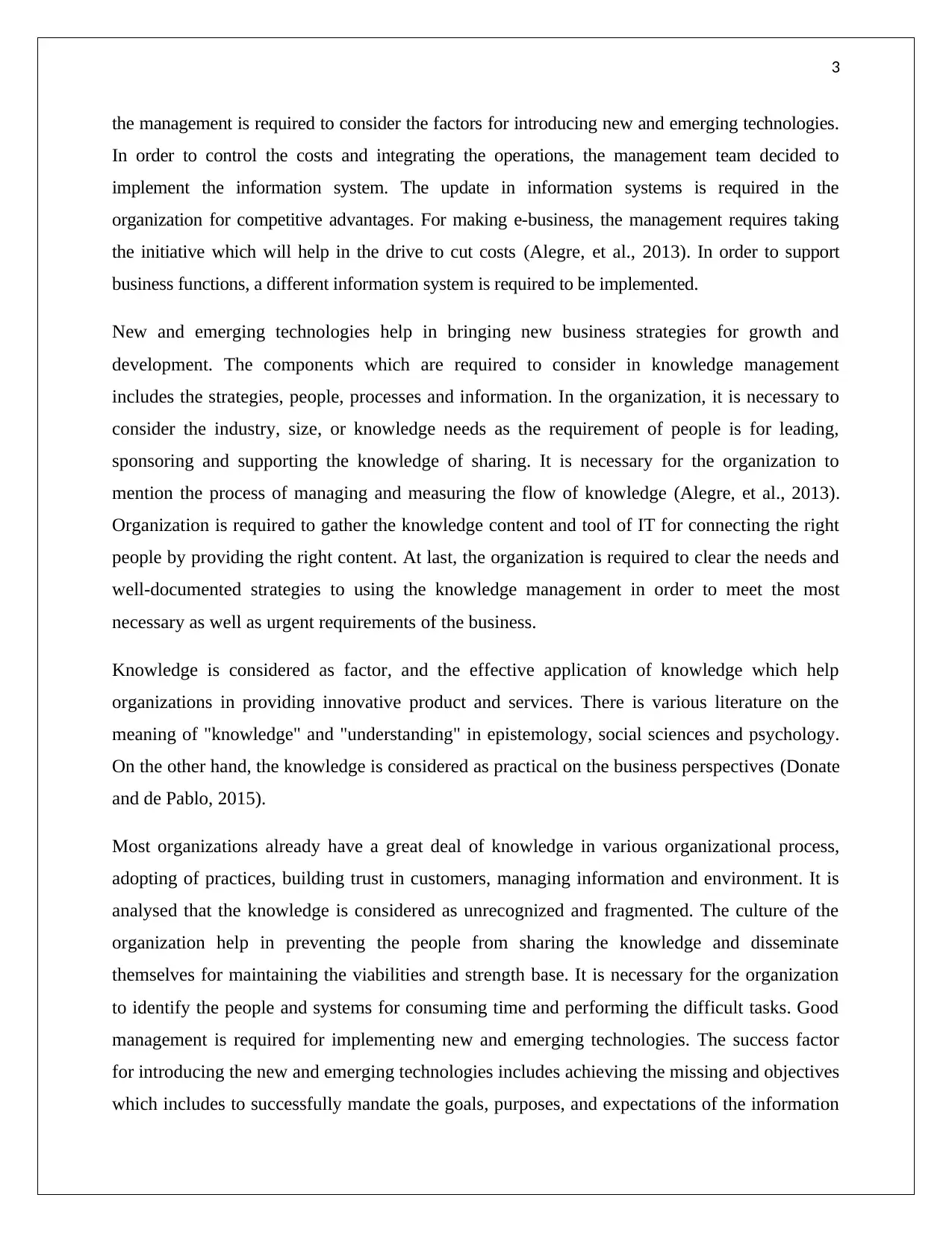
3
the management is required to consider the factors for introducing new and emerging technologies.
In order to control the costs and integrating the operations, the management team decided to
implement the information system. The update in information systems is required in the
organization for competitive advantages. For making e-business, the management requires taking
the initiative which will help in the drive to cut costs (Alegre, et al., 2013). In order to support
business functions, a different information system is required to be implemented.
New and emerging technologies help in bringing new business strategies for growth and
development. The components which are required to consider in knowledge management
includes the strategies, people, processes and information. In the organization, it is necessary to
consider the industry, size, or knowledge needs as the requirement of people is for leading,
sponsoring and supporting the knowledge of sharing. It is necessary for the organization to
mention the process of managing and measuring the flow of knowledge (Alegre, et al., 2013).
Organization is required to gather the knowledge content and tool of IT for connecting the right
people by providing the right content. At last, the organization is required to clear the needs and
well-documented strategies to using the knowledge management in order to meet the most
necessary as well as urgent requirements of the business.
Knowledge is considered as factor, and the effective application of knowledge which help
organizations in providing innovative product and services. There is various literature on the
meaning of "knowledge" and "understanding" in epistemology, social sciences and psychology.
On the other hand, the knowledge is considered as practical on the business perspectives (Donate
and de Pablo, 2015).
Most organizations already have a great deal of knowledge in various organizational process,
adopting of practices, building trust in customers, managing information and environment. It is
analysed that the knowledge is considered as unrecognized and fragmented. The culture of the
organization help in preventing the people from sharing the knowledge and disseminate
themselves for maintaining the viabilities and strength base. It is necessary for the organization
to identify the people and systems for consuming time and performing the difficult tasks. Good
management is required for implementing new and emerging technologies. The success factor
for introducing the new and emerging technologies includes achieving the missing and objectives
which includes to successfully mandate the goals, purposes, and expectations of the information
the management is required to consider the factors for introducing new and emerging technologies.
In order to control the costs and integrating the operations, the management team decided to
implement the information system. The update in information systems is required in the
organization for competitive advantages. For making e-business, the management requires taking
the initiative which will help in the drive to cut costs (Alegre, et al., 2013). In order to support
business functions, a different information system is required to be implemented.
New and emerging technologies help in bringing new business strategies for growth and
development. The components which are required to consider in knowledge management
includes the strategies, people, processes and information. In the organization, it is necessary to
consider the industry, size, or knowledge needs as the requirement of people is for leading,
sponsoring and supporting the knowledge of sharing. It is necessary for the organization to
mention the process of managing and measuring the flow of knowledge (Alegre, et al., 2013).
Organization is required to gather the knowledge content and tool of IT for connecting the right
people by providing the right content. At last, the organization is required to clear the needs and
well-documented strategies to using the knowledge management in order to meet the most
necessary as well as urgent requirements of the business.
Knowledge is considered as factor, and the effective application of knowledge which help
organizations in providing innovative product and services. There is various literature on the
meaning of "knowledge" and "understanding" in epistemology, social sciences and psychology.
On the other hand, the knowledge is considered as practical on the business perspectives (Donate
and de Pablo, 2015).
Most organizations already have a great deal of knowledge in various organizational process,
adopting of practices, building trust in customers, managing information and environment. It is
analysed that the knowledge is considered as unrecognized and fragmented. The culture of the
organization help in preventing the people from sharing the knowledge and disseminate
themselves for maintaining the viabilities and strength base. It is necessary for the organization
to identify the people and systems for consuming time and performing the difficult tasks. Good
management is required for implementing new and emerging technologies. The success factor
for introducing the new and emerging technologies includes achieving the missing and objectives
which includes to successfully mandate the goals, purposes, and expectations of the information
Paraphrase This Document
Need a fresh take? Get an instant paraphrase of this document with our AI Paraphraser
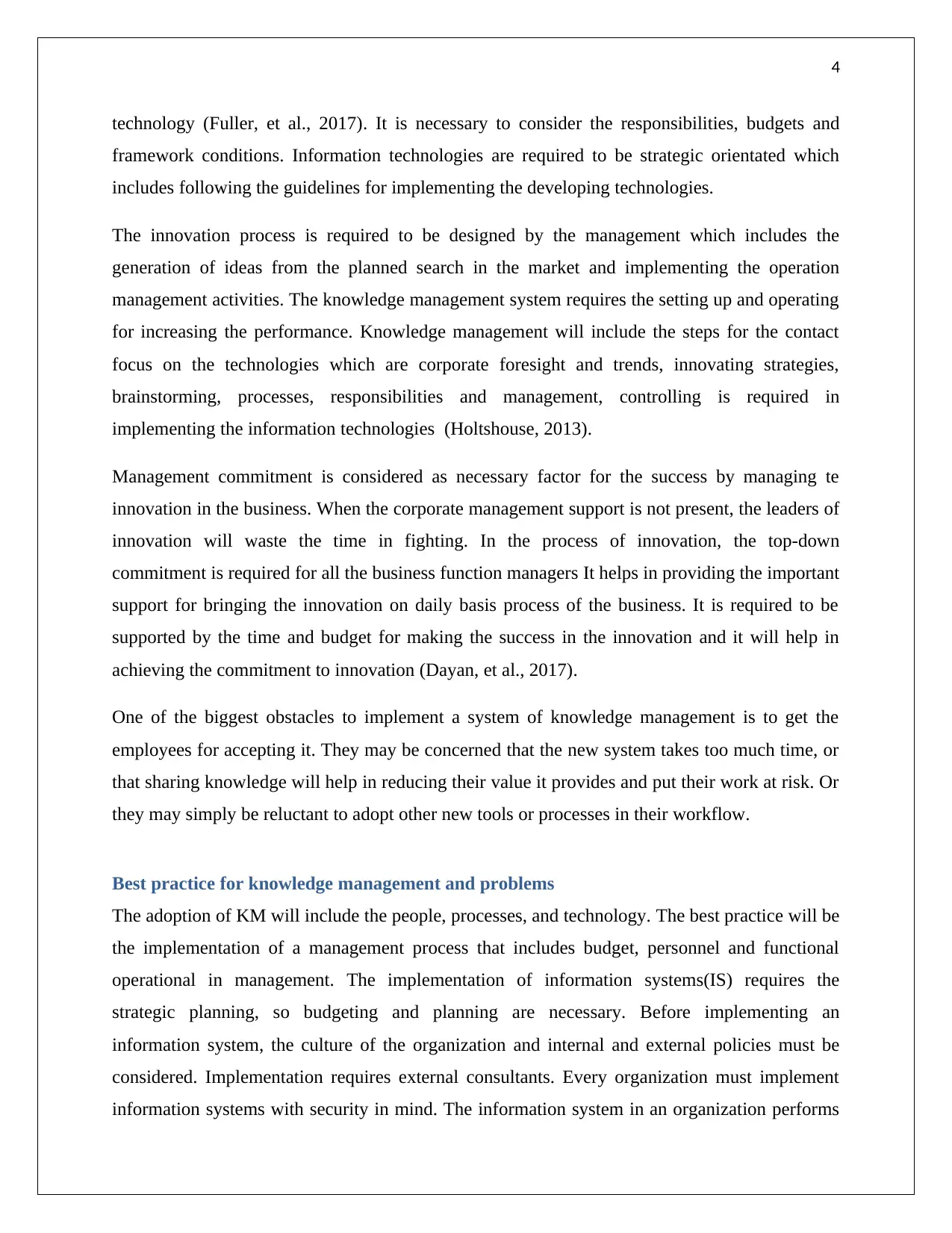
4
technology (Fuller, et al., 2017). It is necessary to consider the responsibilities, budgets and
framework conditions. Information technologies are required to be strategic orientated which
includes following the guidelines for implementing the developing technologies.
The innovation process is required to be designed by the management which includes the
generation of ideas from the planned search in the market and implementing the operation
management activities. The knowledge management system requires the setting up and operating
for increasing the performance. Knowledge management will include the steps for the contact
focus on the technologies which are corporate foresight and trends, innovating strategies,
brainstorming, processes, responsibilities and management, controlling is required in
implementing the information technologies (Holtshouse, 2013).
Management commitment is considered as necessary factor for the success by managing te
innovation in the business. When the corporate management support is not present, the leaders of
innovation will waste the time in fighting. In the process of innovation, the top-down
commitment is required for all the business function managers It helps in providing the important
support for bringing the innovation on daily basis process of the business. It is required to be
supported by the time and budget for making the success in the innovation and it will help in
achieving the commitment to innovation (Dayan, et al., 2017).
One of the biggest obstacles to implement a system of knowledge management is to get the
employees for accepting it. They may be concerned that the new system takes too much time, or
that sharing knowledge will help in reducing their value it provides and put their work at risk. Or
they may simply be reluctant to adopt other new tools or processes in their workflow.
Best practice for knowledge management and problems
The adoption of KM will include the people, processes, and technology. The best practice will be
the implementation of a management process that includes budget, personnel and functional
operational in management. The implementation of information systems(IS) requires the
strategic planning, so budgeting and planning are necessary. Before implementing an
information system, the culture of the organization and internal and external policies must be
considered. Implementation requires external consultants. Every organization must implement
information systems with security in mind. The information system in an organization performs
technology (Fuller, et al., 2017). It is necessary to consider the responsibilities, budgets and
framework conditions. Information technologies are required to be strategic orientated which
includes following the guidelines for implementing the developing technologies.
The innovation process is required to be designed by the management which includes the
generation of ideas from the planned search in the market and implementing the operation
management activities. The knowledge management system requires the setting up and operating
for increasing the performance. Knowledge management will include the steps for the contact
focus on the technologies which are corporate foresight and trends, innovating strategies,
brainstorming, processes, responsibilities and management, controlling is required in
implementing the information technologies (Holtshouse, 2013).
Management commitment is considered as necessary factor for the success by managing te
innovation in the business. When the corporate management support is not present, the leaders of
innovation will waste the time in fighting. In the process of innovation, the top-down
commitment is required for all the business function managers It helps in providing the important
support for bringing the innovation on daily basis process of the business. It is required to be
supported by the time and budget for making the success in the innovation and it will help in
achieving the commitment to innovation (Dayan, et al., 2017).
One of the biggest obstacles to implement a system of knowledge management is to get the
employees for accepting it. They may be concerned that the new system takes too much time, or
that sharing knowledge will help in reducing their value it provides and put their work at risk. Or
they may simply be reluctant to adopt other new tools or processes in their workflow.
Best practice for knowledge management and problems
The adoption of KM will include the people, processes, and technology. The best practice will be
the implementation of a management process that includes budget, personnel and functional
operational in management. The implementation of information systems(IS) requires the
strategic planning, so budgeting and planning are necessary. Before implementing an
information system, the culture of the organization and internal and external policies must be
considered. Implementation requires external consultants. Every organization must implement
information systems with security in mind. The information system in an organization performs
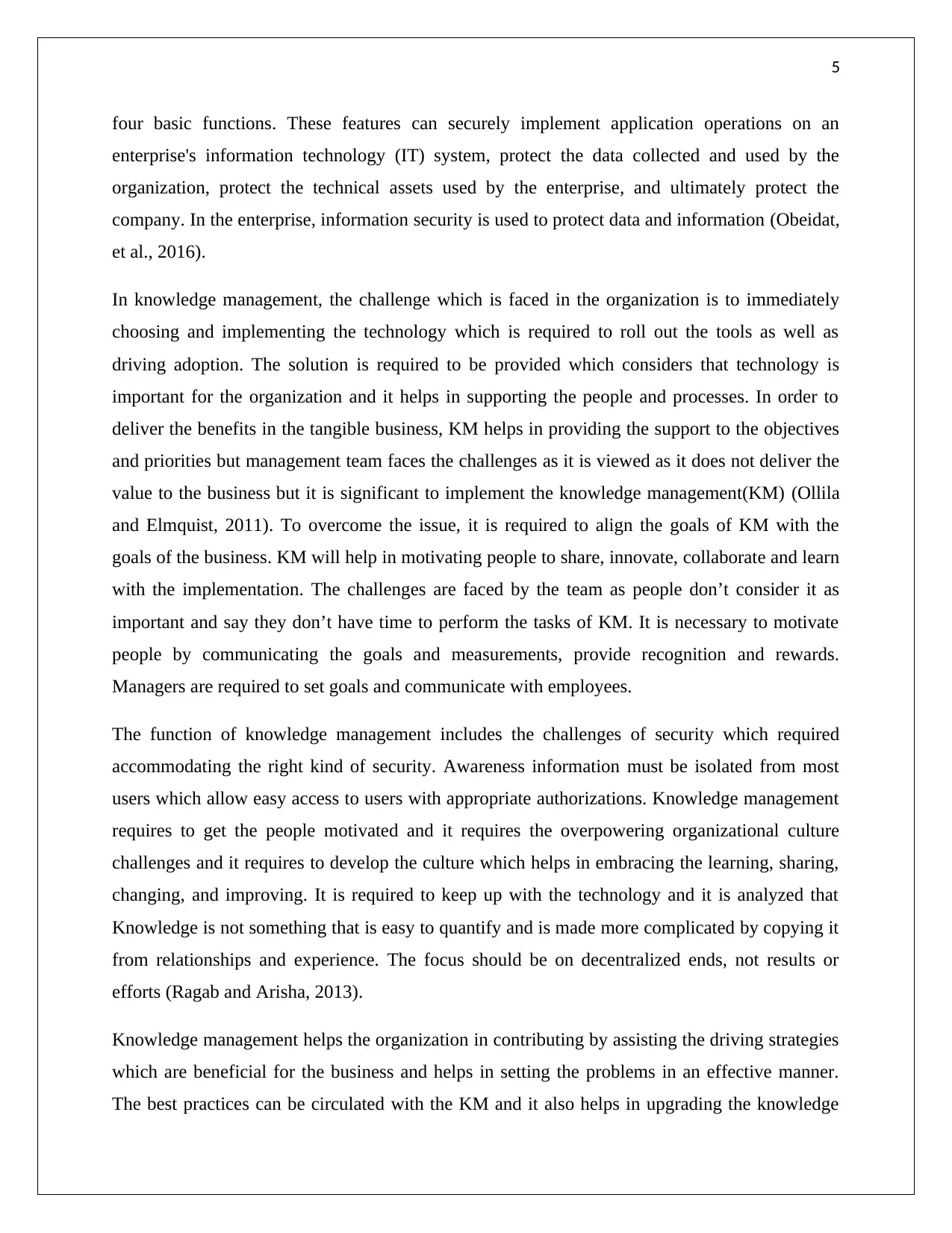
5
four basic functions. These features can securely implement application operations on an
enterprise's information technology (IT) system, protect the data collected and used by the
organization, protect the technical assets used by the enterprise, and ultimately protect the
company. In the enterprise, information security is used to protect data and information (Obeidat,
et al., 2016).
In knowledge management, the challenge which is faced in the organization is to immediately
choosing and implementing the technology which is required to roll out the tools as well as
driving adoption. The solution is required to be provided which considers that technology is
important for the organization and it helps in supporting the people and processes. In order to
deliver the benefits in the tangible business, KM helps in providing the support to the objectives
and priorities but management team faces the challenges as it is viewed as it does not deliver the
value to the business but it is significant to implement the knowledge management(KM) (Ollila
and Elmquist, 2011). To overcome the issue, it is required to align the goals of KM with the
goals of the business. KM will help in motivating people to share, innovate, collaborate and learn
with the implementation. The challenges are faced by the team as people don’t consider it as
important and say they don’t have time to perform the tasks of KM. It is necessary to motivate
people by communicating the goals and measurements, provide recognition and rewards.
Managers are required to set goals and communicate with employees.
The function of knowledge management includes the challenges of security which required
accommodating the right kind of security. Awareness information must be isolated from most
users which allow easy access to users with appropriate authorizations. Knowledge management
requires to get the people motivated and it requires the overpowering organizational culture
challenges and it requires to develop the culture which helps in embracing the learning, sharing,
changing, and improving. It is required to keep up with the technology and it is analyzed that
Knowledge is not something that is easy to quantify and is made more complicated by copying it
from relationships and experience. The focus should be on decentralized ends, not results or
efforts (Ragab and Arisha, 2013).
Knowledge management helps the organization in contributing by assisting the driving strategies
which are beneficial for the business and helps in setting the problems in an effective manner.
The best practices can be circulated with the KM and it also helps in upgrading the knowledge
four basic functions. These features can securely implement application operations on an
enterprise's information technology (IT) system, protect the data collected and used by the
organization, protect the technical assets used by the enterprise, and ultimately protect the
company. In the enterprise, information security is used to protect data and information (Obeidat,
et al., 2016).
In knowledge management, the challenge which is faced in the organization is to immediately
choosing and implementing the technology which is required to roll out the tools as well as
driving adoption. The solution is required to be provided which considers that technology is
important for the organization and it helps in supporting the people and processes. In order to
deliver the benefits in the tangible business, KM helps in providing the support to the objectives
and priorities but management team faces the challenges as it is viewed as it does not deliver the
value to the business but it is significant to implement the knowledge management(KM) (Ollila
and Elmquist, 2011). To overcome the issue, it is required to align the goals of KM with the
goals of the business. KM will help in motivating people to share, innovate, collaborate and learn
with the implementation. The challenges are faced by the team as people don’t consider it as
important and say they don’t have time to perform the tasks of KM. It is necessary to motivate
people by communicating the goals and measurements, provide recognition and rewards.
Managers are required to set goals and communicate with employees.
The function of knowledge management includes the challenges of security which required
accommodating the right kind of security. Awareness information must be isolated from most
users which allow easy access to users with appropriate authorizations. Knowledge management
requires to get the people motivated and it requires the overpowering organizational culture
challenges and it requires to develop the culture which helps in embracing the learning, sharing,
changing, and improving. It is required to keep up with the technology and it is analyzed that
Knowledge is not something that is easy to quantify and is made more complicated by copying it
from relationships and experience. The focus should be on decentralized ends, not results or
efforts (Ragab and Arisha, 2013).
Knowledge management helps the organization in contributing by assisting the driving strategies
which are beneficial for the business and helps in setting the problems in an effective manner.
The best practices can be circulated with the KM and it also helps in upgrading the knowledge
⊘ This is a preview!⊘
Do you want full access?
Subscribe today to unlock all pages.

Trusted by 1+ million students worldwide
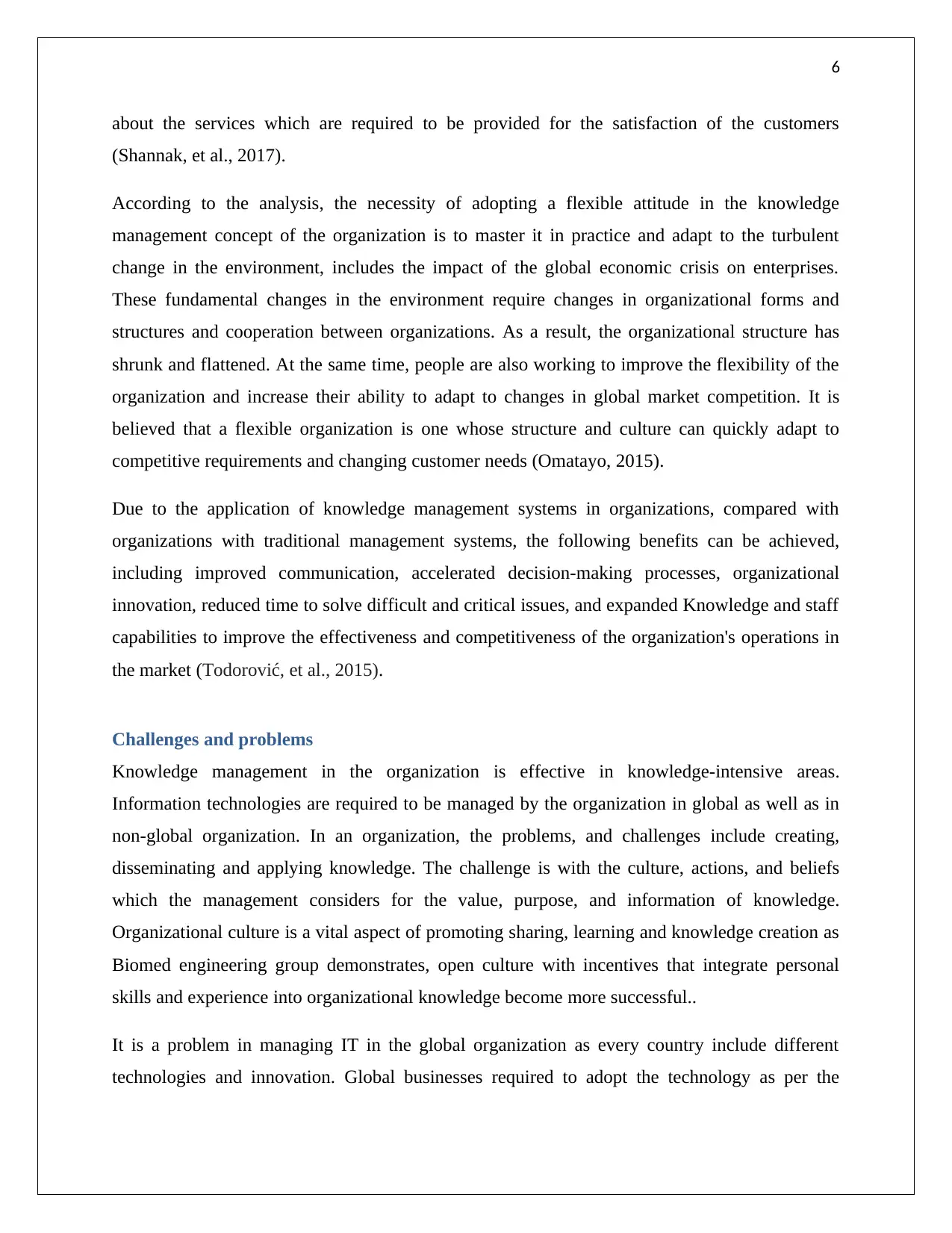
6
about the services which are required to be provided for the satisfaction of the customers
(Shannak, et al., 2017).
According to the analysis, the necessity of adopting a flexible attitude in the knowledge
management concept of the organization is to master it in practice and adapt to the turbulent
change in the environment, includes the impact of the global economic crisis on enterprises.
These fundamental changes in the environment require changes in organizational forms and
structures and cooperation between organizations. As a result, the organizational structure has
shrunk and flattened. At the same time, people are also working to improve the flexibility of the
organization and increase their ability to adapt to changes in global market competition. It is
believed that a flexible organization is one whose structure and culture can quickly adapt to
competitive requirements and changing customer needs (Omatayo, 2015).
Due to the application of knowledge management systems in organizations, compared with
organizations with traditional management systems, the following benefits can be achieved,
including improved communication, accelerated decision-making processes, organizational
innovation, reduced time to solve difficult and critical issues, and expanded Knowledge and staff
capabilities to improve the effectiveness and competitiveness of the organization's operations in
the market (Todorović, et al., 2015).
Challenges and problems
Knowledge management in the organization is effective in knowledge-intensive areas.
Information technologies are required to be managed by the organization in global as well as in
non-global organization. In an organization, the problems, and challenges include creating,
disseminating and applying knowledge. The challenge is with the culture, actions, and beliefs
which the management considers for the value, purpose, and information of knowledge.
Organizational culture is a vital aspect of promoting sharing, learning and knowledge creation as
Biomed engineering group demonstrates, open culture with incentives that integrate personal
skills and experience into organizational knowledge become more successful..
It is a problem in managing IT in the global organization as every country include different
technologies and innovation. Global businesses required to adopt the technology as per the
about the services which are required to be provided for the satisfaction of the customers
(Shannak, et al., 2017).
According to the analysis, the necessity of adopting a flexible attitude in the knowledge
management concept of the organization is to master it in practice and adapt to the turbulent
change in the environment, includes the impact of the global economic crisis on enterprises.
These fundamental changes in the environment require changes in organizational forms and
structures and cooperation between organizations. As a result, the organizational structure has
shrunk and flattened. At the same time, people are also working to improve the flexibility of the
organization and increase their ability to adapt to changes in global market competition. It is
believed that a flexible organization is one whose structure and culture can quickly adapt to
competitive requirements and changing customer needs (Omatayo, 2015).
Due to the application of knowledge management systems in organizations, compared with
organizations with traditional management systems, the following benefits can be achieved,
including improved communication, accelerated decision-making processes, organizational
innovation, reduced time to solve difficult and critical issues, and expanded Knowledge and staff
capabilities to improve the effectiveness and competitiveness of the organization's operations in
the market (Todorović, et al., 2015).
Challenges and problems
Knowledge management in the organization is effective in knowledge-intensive areas.
Information technologies are required to be managed by the organization in global as well as in
non-global organization. In an organization, the problems, and challenges include creating,
disseminating and applying knowledge. The challenge is with the culture, actions, and beliefs
which the management considers for the value, purpose, and information of knowledge.
Organizational culture is a vital aspect of promoting sharing, learning and knowledge creation as
Biomed engineering group demonstrates, open culture with incentives that integrate personal
skills and experience into organizational knowledge become more successful..
It is a problem in managing IT in the global organization as every country include different
technologies and innovation. Global businesses required to adopt the technology as per the
Paraphrase This Document
Need a fresh take? Get an instant paraphrase of this document with our AI Paraphraser
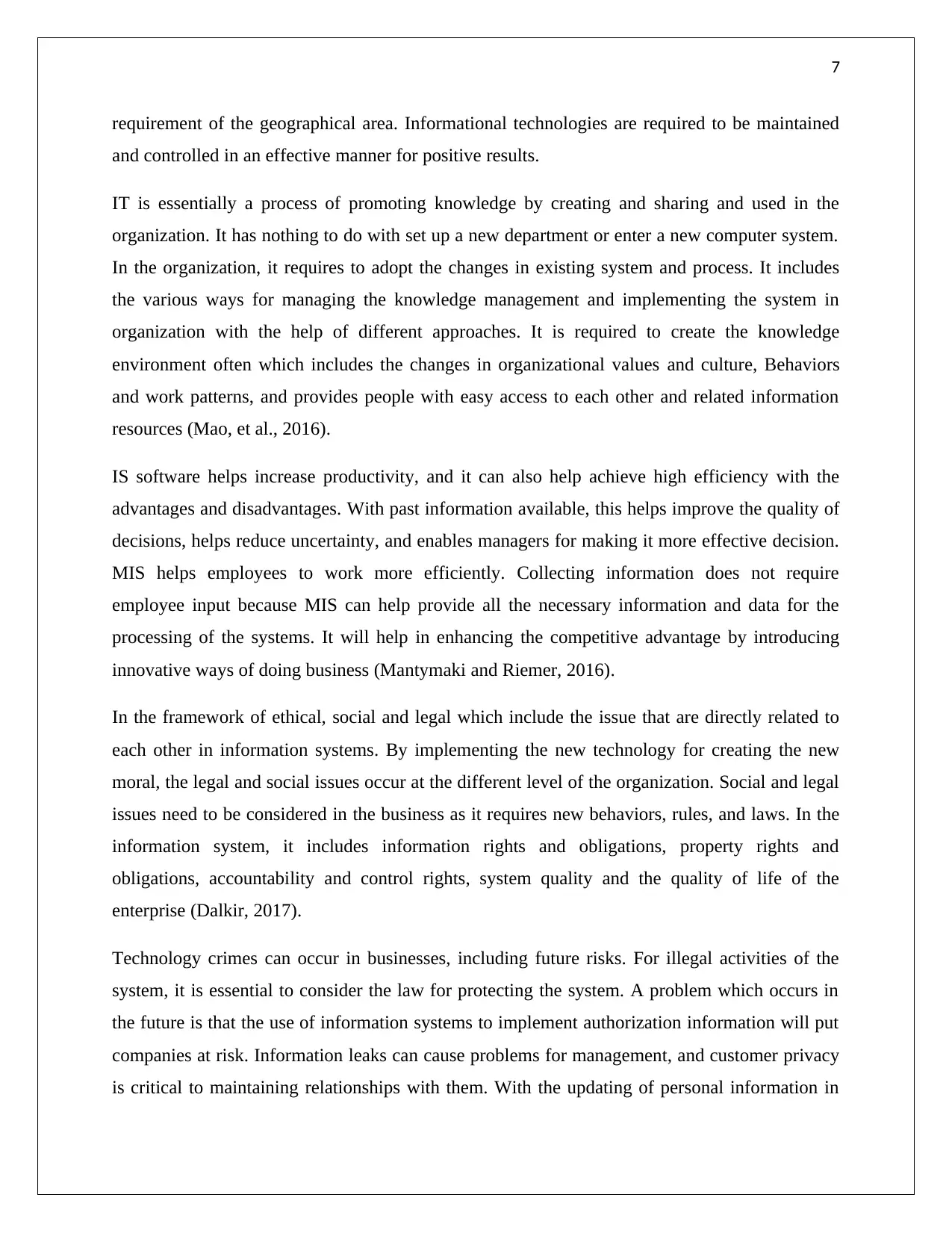
7
requirement of the geographical area. Informational technologies are required to be maintained
and controlled in an effective manner for positive results.
IT is essentially a process of promoting knowledge by creating and sharing and used in the
organization. It has nothing to do with set up a new department or enter a new computer system.
In the organization, it requires to adopt the changes in existing system and process. It includes
the various ways for managing the knowledge management and implementing the system in
organization with the help of different approaches. It is required to create the knowledge
environment often which includes the changes in organizational values and culture, Behaviors
and work patterns, and provides people with easy access to each other and related information
resources (Mao, et al., 2016).
IS software helps increase productivity, and it can also help achieve high efficiency with the
advantages and disadvantages. With past information available, this helps improve the quality of
decisions, helps reduce uncertainty, and enables managers for making it more effective decision.
MIS helps employees to work more efficiently. Collecting information does not require
employee input because MIS can help provide all the necessary information and data for the
processing of the systems. It will help in enhancing the competitive advantage by introducing
innovative ways of doing business (Mantymaki and Riemer, 2016).
In the framework of ethical, social and legal which include the issue that are directly related to
each other in information systems. By implementing the new technology for creating the new
moral, the legal and social issues occur at the different level of the organization. Social and legal
issues need to be considered in the business as it requires new behaviors, rules, and laws. In the
information system, it includes information rights and obligations, property rights and
obligations, accountability and control rights, system quality and the quality of life of the
enterprise (Dalkir, 2017).
Technology crimes can occur in businesses, including future risks. For illegal activities of the
system, it is essential to consider the law for protecting the system. A problem which occurs in
the future is that the use of information systems to implement authorization information will put
companies at risk. Information leaks can cause problems for management, and customer privacy
is critical to maintaining relationships with them. With the updating of personal information in
requirement of the geographical area. Informational technologies are required to be maintained
and controlled in an effective manner for positive results.
IT is essentially a process of promoting knowledge by creating and sharing and used in the
organization. It has nothing to do with set up a new department or enter a new computer system.
In the organization, it requires to adopt the changes in existing system and process. It includes
the various ways for managing the knowledge management and implementing the system in
organization with the help of different approaches. It is required to create the knowledge
environment often which includes the changes in organizational values and culture, Behaviors
and work patterns, and provides people with easy access to each other and related information
resources (Mao, et al., 2016).
IS software helps increase productivity, and it can also help achieve high efficiency with the
advantages and disadvantages. With past information available, this helps improve the quality of
decisions, helps reduce uncertainty, and enables managers for making it more effective decision.
MIS helps employees to work more efficiently. Collecting information does not require
employee input because MIS can help provide all the necessary information and data for the
processing of the systems. It will help in enhancing the competitive advantage by introducing
innovative ways of doing business (Mantymaki and Riemer, 2016).
In the framework of ethical, social and legal which include the issue that are directly related to
each other in information systems. By implementing the new technology for creating the new
moral, the legal and social issues occur at the different level of the organization. Social and legal
issues need to be considered in the business as it requires new behaviors, rules, and laws. In the
information system, it includes information rights and obligations, property rights and
obligations, accountability and control rights, system quality and the quality of life of the
enterprise (Dalkir, 2017).
Technology crimes can occur in businesses, including future risks. For illegal activities of the
system, it is essential to consider the law for protecting the system. A problem which occurs in
the future is that the use of information systems to implement authorization information will put
companies at risk. Information leaks can cause problems for management, and customer privacy
is critical to maintaining relationships with them. With the updating of personal information in
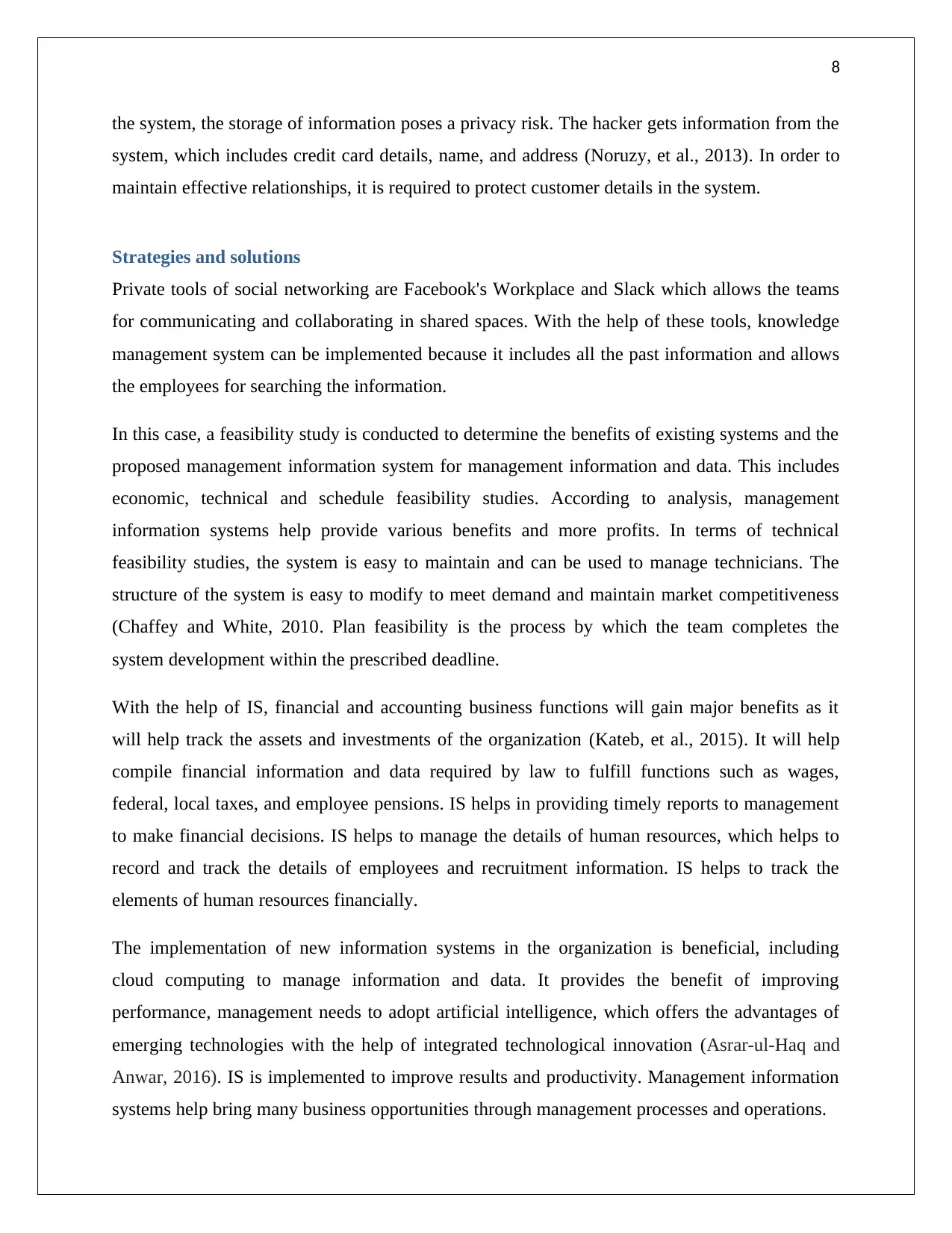
8
the system, the storage of information poses a privacy risk. The hacker gets information from the
system, which includes credit card details, name, and address (Noruzy, et al., 2013). In order to
maintain effective relationships, it is required to protect customer details in the system.
Strategies and solutions
Private tools of social networking are Facebook's Workplace and Slack which allows the teams
for communicating and collaborating in shared spaces. With the help of these tools, knowledge
management system can be implemented because it includes all the past information and allows
the employees for searching the information.
In this case, a feasibility study is conducted to determine the benefits of existing systems and the
proposed management information system for management information and data. This includes
economic, technical and schedule feasibility studies. According to analysis, management
information systems help provide various benefits and more profits. In terms of technical
feasibility studies, the system is easy to maintain and can be used to manage technicians. The
structure of the system is easy to modify to meet demand and maintain market competitiveness
(Chaffey and White, 2010. Plan feasibility is the process by which the team completes the
system development within the prescribed deadline.
With the help of IS, financial and accounting business functions will gain major benefits as it
will help track the assets and investments of the organization (Kateb, et al., 2015). It will help
compile financial information and data required by law to fulfill functions such as wages,
federal, local taxes, and employee pensions. IS helps in providing timely reports to management
to make financial decisions. IS helps to manage the details of human resources, which helps to
record and track the details of employees and recruitment information. IS helps to track the
elements of human resources financially.
The implementation of new information systems in the organization is beneficial, including
cloud computing to manage information and data. It provides the benefit of improving
performance, management needs to adopt artificial intelligence, which offers the advantages of
emerging technologies with the help of integrated technological innovation (Asrar-ul-Haq and
Anwar, 2016). IS is implemented to improve results and productivity. Management information
systems help bring many business opportunities through management processes and operations.
the system, the storage of information poses a privacy risk. The hacker gets information from the
system, which includes credit card details, name, and address (Noruzy, et al., 2013). In order to
maintain effective relationships, it is required to protect customer details in the system.
Strategies and solutions
Private tools of social networking are Facebook's Workplace and Slack which allows the teams
for communicating and collaborating in shared spaces. With the help of these tools, knowledge
management system can be implemented because it includes all the past information and allows
the employees for searching the information.
In this case, a feasibility study is conducted to determine the benefits of existing systems and the
proposed management information system for management information and data. This includes
economic, technical and schedule feasibility studies. According to analysis, management
information systems help provide various benefits and more profits. In terms of technical
feasibility studies, the system is easy to maintain and can be used to manage technicians. The
structure of the system is easy to modify to meet demand and maintain market competitiveness
(Chaffey and White, 2010. Plan feasibility is the process by which the team completes the
system development within the prescribed deadline.
With the help of IS, financial and accounting business functions will gain major benefits as it
will help track the assets and investments of the organization (Kateb, et al., 2015). It will help
compile financial information and data required by law to fulfill functions such as wages,
federal, local taxes, and employee pensions. IS helps in providing timely reports to management
to make financial decisions. IS helps to manage the details of human resources, which helps to
record and track the details of employees and recruitment information. IS helps to track the
elements of human resources financially.
The implementation of new information systems in the organization is beneficial, including
cloud computing to manage information and data. It provides the benefit of improving
performance, management needs to adopt artificial intelligence, which offers the advantages of
emerging technologies with the help of integrated technological innovation (Asrar-ul-Haq and
Anwar, 2016). IS is implemented to improve results and productivity. Management information
systems help bring many business opportunities through management processes and operations.
⊘ This is a preview!⊘
Do you want full access?
Subscribe today to unlock all pages.

Trusted by 1+ million students worldwide
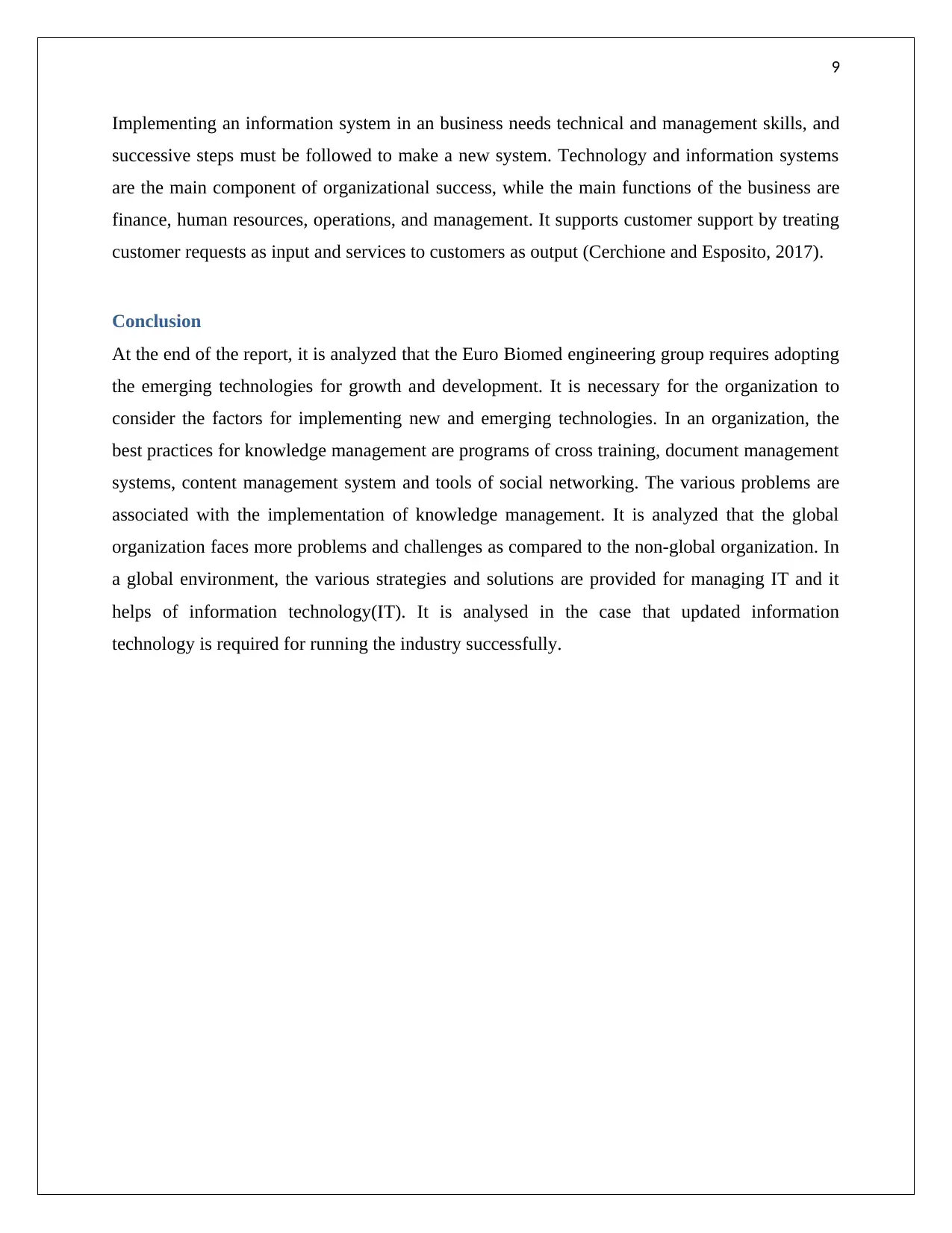
9
Implementing an information system in an business needs technical and management skills, and
successive steps must be followed to make a new system. Technology and information systems
are the main component of organizational success, while the main functions of the business are
finance, human resources, operations, and management. It supports customer support by treating
customer requests as input and services to customers as output (Cerchione and Esposito, 2017).
Conclusion
At the end of the report, it is analyzed that the Euro Biomed engineering group requires adopting
the emerging technologies for growth and development. It is necessary for the organization to
consider the factors for implementing new and emerging technologies. In an organization, the
best practices for knowledge management are programs of cross training, document management
systems, content management system and tools of social networking. The various problems are
associated with the implementation of knowledge management. It is analyzed that the global
organization faces more problems and challenges as compared to the non-global organization. In
a global environment, the various strategies and solutions are provided for managing IT and it
helps of information technology(IT). It is analysed in the case that updated information
technology is required for running the industry successfully.
Implementing an information system in an business needs technical and management skills, and
successive steps must be followed to make a new system. Technology and information systems
are the main component of organizational success, while the main functions of the business are
finance, human resources, operations, and management. It supports customer support by treating
customer requests as input and services to customers as output (Cerchione and Esposito, 2017).
Conclusion
At the end of the report, it is analyzed that the Euro Biomed engineering group requires adopting
the emerging technologies for growth and development. It is necessary for the organization to
consider the factors for implementing new and emerging technologies. In an organization, the
best practices for knowledge management are programs of cross training, document management
systems, content management system and tools of social networking. The various problems are
associated with the implementation of knowledge management. It is analyzed that the global
organization faces more problems and challenges as compared to the non-global organization. In
a global environment, the various strategies and solutions are provided for managing IT and it
helps of information technology(IT). It is analysed in the case that updated information
technology is required for running the industry successfully.
Paraphrase This Document
Need a fresh take? Get an instant paraphrase of this document with our AI Paraphraser
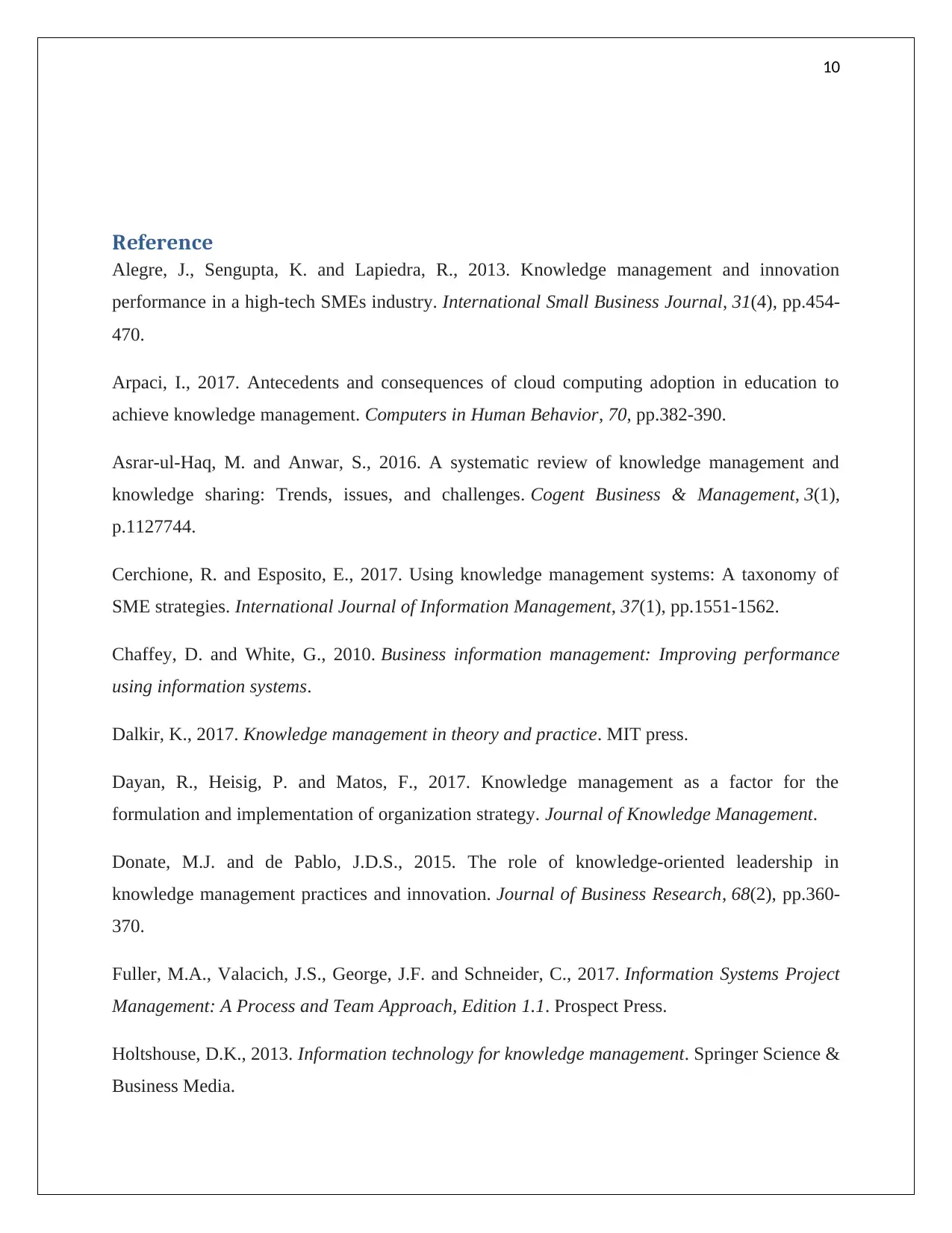
10
Reference
Alegre, J., Sengupta, K. and Lapiedra, R., 2013. Knowledge management and innovation
performance in a high-tech SMEs industry. International Small Business Journal, 31(4), pp.454-
470.
Arpaci, I., 2017. Antecedents and consequences of cloud computing adoption in education to
achieve knowledge management. Computers in Human Behavior, 70, pp.382-390.
Asrar-ul-Haq, M. and Anwar, S., 2016. A systematic review of knowledge management and
knowledge sharing: Trends, issues, and challenges. Cogent Business & Management, 3(1),
p.1127744.
Cerchione, R. and Esposito, E., 2017. Using knowledge management systems: A taxonomy of
SME strategies. International Journal of Information Management, 37(1), pp.1551-1562.
Chaffey, D. and White, G., 2010. Business information management: Improving performance
using information systems.
Dalkir, K., 2017. Knowledge management in theory and practice. MIT press.
Dayan, R., Heisig, P. and Matos, F., 2017. Knowledge management as a factor for the
formulation and implementation of organization strategy. Journal of Knowledge Management.
Donate, M.J. and de Pablo, J.D.S., 2015. The role of knowledge-oriented leadership in
knowledge management practices and innovation. Journal of Business Research, 68(2), pp.360-
370.
Fuller, M.A., Valacich, J.S., George, J.F. and Schneider, C., 2017. Information Systems Project
Management: A Process and Team Approach, Edition 1.1. Prospect Press.
Holtshouse, D.K., 2013. Information technology for knowledge management. Springer Science &
Business Media.
Reference
Alegre, J., Sengupta, K. and Lapiedra, R., 2013. Knowledge management and innovation
performance in a high-tech SMEs industry. International Small Business Journal, 31(4), pp.454-
470.
Arpaci, I., 2017. Antecedents and consequences of cloud computing adoption in education to
achieve knowledge management. Computers in Human Behavior, 70, pp.382-390.
Asrar-ul-Haq, M. and Anwar, S., 2016. A systematic review of knowledge management and
knowledge sharing: Trends, issues, and challenges. Cogent Business & Management, 3(1),
p.1127744.
Cerchione, R. and Esposito, E., 2017. Using knowledge management systems: A taxonomy of
SME strategies. International Journal of Information Management, 37(1), pp.1551-1562.
Chaffey, D. and White, G., 2010. Business information management: Improving performance
using information systems.
Dalkir, K., 2017. Knowledge management in theory and practice. MIT press.
Dayan, R., Heisig, P. and Matos, F., 2017. Knowledge management as a factor for the
formulation and implementation of organization strategy. Journal of Knowledge Management.
Donate, M.J. and de Pablo, J.D.S., 2015. The role of knowledge-oriented leadership in
knowledge management practices and innovation. Journal of Business Research, 68(2), pp.360-
370.
Fuller, M.A., Valacich, J.S., George, J.F. and Schneider, C., 2017. Information Systems Project
Management: A Process and Team Approach, Edition 1.1. Prospect Press.
Holtshouse, D.K., 2013. Information technology for knowledge management. Springer Science &
Business Media.
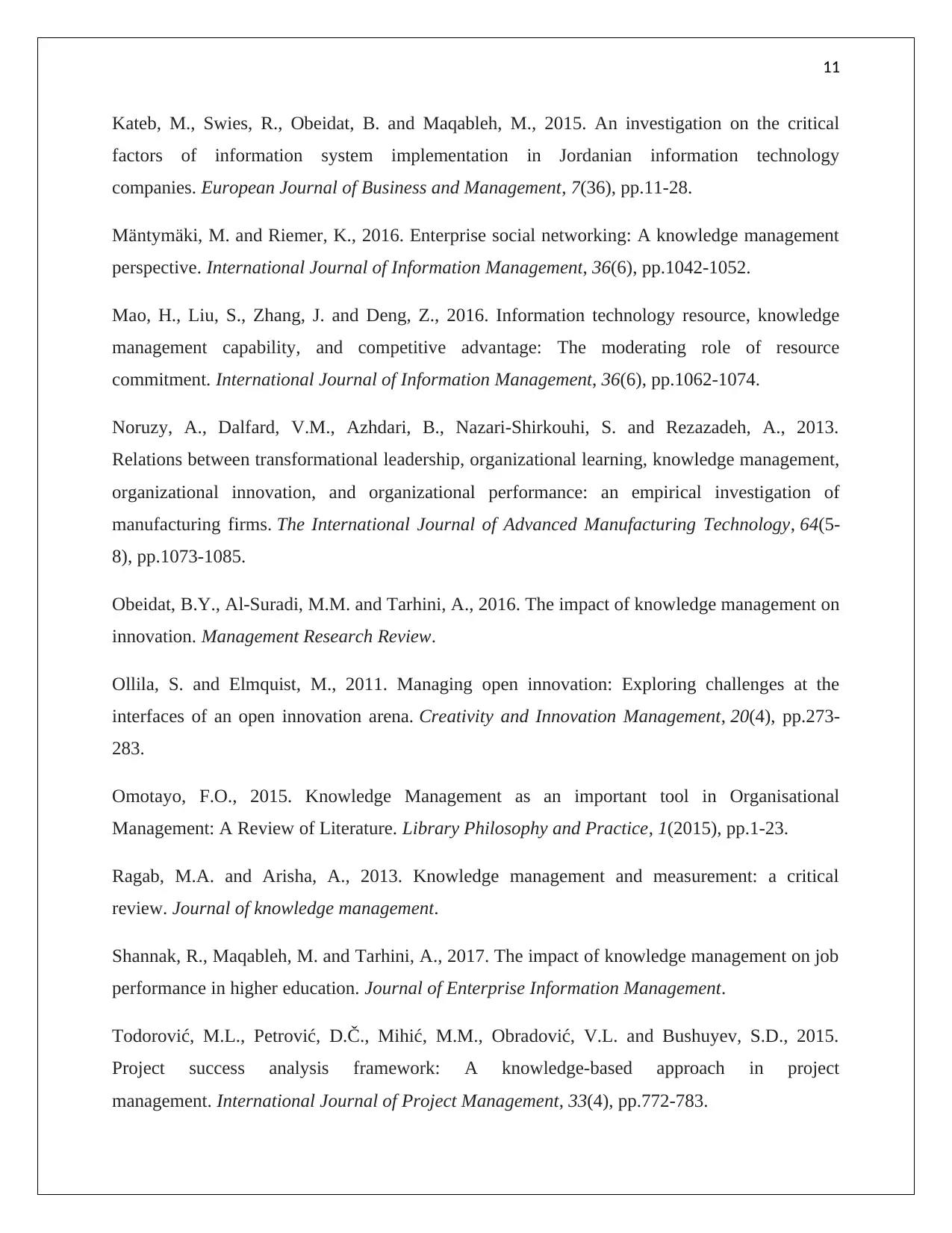
11
Kateb, M., Swies, R., Obeidat, B. and Maqableh, M., 2015. An investigation on the critical
factors of information system implementation in Jordanian information technology
companies. European Journal of Business and Management, 7(36), pp.11-28.
Mäntymäki, M. and Riemer, K., 2016. Enterprise social networking: A knowledge management
perspective. International Journal of Information Management, 36(6), pp.1042-1052.
Mao, H., Liu, S., Zhang, J. and Deng, Z., 2016. Information technology resource, knowledge
management capability, and competitive advantage: The moderating role of resource
commitment. International Journal of Information Management, 36(6), pp.1062-1074.
Noruzy, A., Dalfard, V.M., Azhdari, B., Nazari-Shirkouhi, S. and Rezazadeh, A., 2013.
Relations between transformational leadership, organizational learning, knowledge management,
organizational innovation, and organizational performance: an empirical investigation of
manufacturing firms. The International Journal of Advanced Manufacturing Technology, 64(5-
8), pp.1073-1085.
Obeidat, B.Y., Al-Suradi, M.M. and Tarhini, A., 2016. The impact of knowledge management on
innovation. Management Research Review.
Ollila, S. and Elmquist, M., 2011. Managing open innovation: Exploring challenges at the
interfaces of an open innovation arena. Creativity and Innovation Management, 20(4), pp.273-
283.
Omotayo, F.O., 2015. Knowledge Management as an important tool in Organisational
Management: A Review of Literature. Library Philosophy and Practice, 1(2015), pp.1-23.
Ragab, M.A. and Arisha, A., 2013. Knowledge management and measurement: a critical
review. Journal of knowledge management.
Shannak, R., Maqableh, M. and Tarhini, A., 2017. The impact of knowledge management on job
performance in higher education. Journal of Enterprise Information Management.
Todorović, M.L., Petrović, D.Č., Mihić, M.M., Obradović, V.L. and Bushuyev, S.D., 2015.
Project success analysis framework: A knowledge-based approach in project
management. International Journal of Project Management, 33(4), pp.772-783.
Kateb, M., Swies, R., Obeidat, B. and Maqableh, M., 2015. An investigation on the critical
factors of information system implementation in Jordanian information technology
companies. European Journal of Business and Management, 7(36), pp.11-28.
Mäntymäki, M. and Riemer, K., 2016. Enterprise social networking: A knowledge management
perspective. International Journal of Information Management, 36(6), pp.1042-1052.
Mao, H., Liu, S., Zhang, J. and Deng, Z., 2016. Information technology resource, knowledge
management capability, and competitive advantage: The moderating role of resource
commitment. International Journal of Information Management, 36(6), pp.1062-1074.
Noruzy, A., Dalfard, V.M., Azhdari, B., Nazari-Shirkouhi, S. and Rezazadeh, A., 2013.
Relations between transformational leadership, organizational learning, knowledge management,
organizational innovation, and organizational performance: an empirical investigation of
manufacturing firms. The International Journal of Advanced Manufacturing Technology, 64(5-
8), pp.1073-1085.
Obeidat, B.Y., Al-Suradi, M.M. and Tarhini, A., 2016. The impact of knowledge management on
innovation. Management Research Review.
Ollila, S. and Elmquist, M., 2011. Managing open innovation: Exploring challenges at the
interfaces of an open innovation arena. Creativity and Innovation Management, 20(4), pp.273-
283.
Omotayo, F.O., 2015. Knowledge Management as an important tool in Organisational
Management: A Review of Literature. Library Philosophy and Practice, 1(2015), pp.1-23.
Ragab, M.A. and Arisha, A., 2013. Knowledge management and measurement: a critical
review. Journal of knowledge management.
Shannak, R., Maqableh, M. and Tarhini, A., 2017. The impact of knowledge management on job
performance in higher education. Journal of Enterprise Information Management.
Todorović, M.L., Petrović, D.Č., Mihić, M.M., Obradović, V.L. and Bushuyev, S.D., 2015.
Project success analysis framework: A knowledge-based approach in project
management. International Journal of Project Management, 33(4), pp.772-783.
⊘ This is a preview!⊘
Do you want full access?
Subscribe today to unlock all pages.

Trusted by 1+ million students worldwide
1 out of 12
Related Documents
Your All-in-One AI-Powered Toolkit for Academic Success.
+13062052269
info@desklib.com
Available 24*7 on WhatsApp / Email
![[object Object]](/_next/static/media/star-bottom.7253800d.svg)
Unlock your academic potential
Copyright © 2020–2025 A2Z Services. All Rights Reserved. Developed and managed by ZUCOL.





